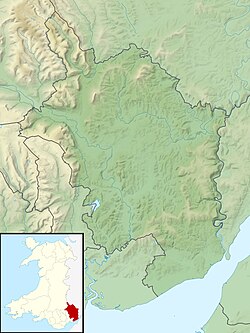Top Qs
Timeline
Chat
Perspective
Llwyn-celyn Farmhouse
Farmhouse in Llanvihangel Crucorney, Monmouthshire From Wikipedia, the free encyclopedia
Remove ads
Llwyn-celyn Farmhouse, Llanvihangel Crucorney, Monmouthshire is a farmhouse of late medieval origins. It is a Grade I listed building.
Remove ads
Remove ads
History
The original farmhouse is a late-medieval hall house of c.1420.[1] In the late 17th century, both the hall, and the attached solar block were horizontally divided to create two-storeyed buildings.[2] An outhouse, with what was originally a free-standing kitchen, was linked to the main block in the 19th century, when the farm was part of the Llanthony Priory estate and owned by the poet Walter Savage Landor.[3]
There were subsequently almost no alterations made to the building for over 100 years.[2] By the early 21st century, the house was in a state of decay and, in 2014, ownership passed to the Landmark Trust. The Trust commenced a £4.5m restoration, which is largely complete as of November 2018.[4]
Remove ads
Architecture and description
The architectural historian John Newman describes the farmhouse as "quite exceptional, a complete late medieval hall house, all of stone."[5] Sir Cyril Fox and Lord Raglan, in the first of their three-volume study Monmouthshire Houses, give a construction date of c.1500, slightly later than that posited by Cadw and the Landmark Trust.[6] The roofs of the, now two-storeyed, hall and parlour show evidence of smoke-blackening, indicating that they were "originally open full-height."[5] Peter Smith, in his study Houses of the Welsh Countryside, notes the innovatory treatment of the hall and cross-passage.[7] The exterior is of Old Red Sandstone rubble.[3]
Remove ads
Notes
References
Wikiwand - on
Seamless Wikipedia browsing. On steroids.
Remove ads


